Turbulence Models Studying the Airflow around a Greenhouse Based in a Wind Tunnel and Under Different Conditions
Abstract
:1. Introduction
2. Materials and Methods
2.1. Wind Tunnel Characteristics
2.2. Mathematical Model
- ρ: the density of the fluid (kg m−3);
- u: flow velocity (m s−1);
- L: the characteristic flow length (m);
- μ: dynamic viscosity (Pa s);
- ν: kinematic viscosity (m2 s−1).
- Inlet: velocity 0.34, 1, 10 m/s
- Wall treatment: ground, greenhouse line and top of the channel: non-slip condition
- Solver: SIMPLE algorithm was applied
- Outlet: gauge pressure 0
- Differential schemes: Finite Volume Method (FEM)
- In all the models Standard Wall Function was implemented.
- The solution’s convergence criteria were set as follows:
- Continuity: 10-5
- X = velocity: 10-5
- k: 10-5
- ε: 10-5
- No of iterations: 1000
2.3. Computational Mesh
3. Results and Discussion
3.1. Pressure Distributions
3.2. Air Velocity Distributions
3.3. Horizontal Speed Distributions (u)
4. Conclusions
- The results of k–ε models for pressure and velocity converged when the velocity of the air was high enough to ensure that the flow was turbulent. The results showed that the three models converge significantly when the inlet air velocity reaches 10 m/s, and thus all three models are suitable for this air velocity value.
- The presence of turbulence in the flow can be diagnosed by analyzing the airflow velocity profiles. The horizontal velocity profile has a key role in this investigation.
- For a greenhouse with an arched roof, there are three areas in which vortices develop. These are upstream, above the roof and downstream.
- As the flow velocity increases, the magnitude of the vortex upstream of the obstacle decreases, resulting in its elimination at very high velocities.
- The vortex that appears on the roof of the obstacle is an extension of the vortex created downstream of the obstacle.
Author Contributions
Funding
Institutional Review Board Statement
Informed Consent Statement
Data Availability Statement
Conflicts of Interest
References
- Bartzanas, T.; Kittas, C.; Sapounas, A.A.; Nikita-Martzopoulou, C. Analysis of airflow through experimental rural buildings: Sensitivity to turbulence models. Biosyst. Eng. 2007, 97, 229–239. [Google Scholar] [CrossRef]
- Norton, T.; Grant, J.; Fallon, R.; Sun, D.W. Improving the representation of thermal boundary conditions of livestock during CFD modeling of the indoor environment. Comput. Electron. Agric. 2010, 73, 17–36. [Google Scholar] [CrossRef]
- Shen, X.; Zhang, G.; Bjerg, B. Comparison of different methods for estimating ventilation rates through wind driven ventilated buildings. Energy Build. 2012, 23, 297–306. [Google Scholar] [CrossRef]
- Vogiatzis, I.; Denizopoulou, A.C.; Ntinas, G.K.; Fragos, V.P. Simulation analysis of air flow and turbulence statistics in a rib grit roughened duct. Sci. World J. 2014, 2014, 791513. [Google Scholar] [CrossRef]
- Ntinas, G.K.; Denizopoulou, A.C.; Kotsopoulos, T.A.; Fragos, V.P. Numerical Approximation of Airflow inside an Agricultural Structure. Sci. Technol. Built Environ. Sci. Technol. Built Environ. 2017, 23, 382–390. [Google Scholar] [CrossRef]
- Ntinas, G.K.; Dados, N.J.; Shen, X.; Malamataris, N.; Fragos, V.P.; Zhang, G. Characteristics of unsteady flow around two successive rectangular ribs on floor of a wind tunnel. Eur. J. Mech. –B/Fluids 2017, 63, 450–458. [Google Scholar] [CrossRef]
- Norton, T.; Sun, D.W.; Grant, J.; Fallon, R.; Dodd, V. Applications of computational fluid dynamics (CFD) in the modelling and design of ventilation systems in the agricultural industry: A review. Bioresour. Technol. 2007, 98, 2386–2414. [Google Scholar] [CrossRef]
- Ntinas, G.K.; Shen, X.; Wang, Y.; Zhang, G. Evaluation of CFD turbulence models for simulating external airflow around varied building roof with wind tunnel experiment. Build. Simul. 2018, 11, 115–123. [Google Scholar] [CrossRef]
- Kim, R.W.; Lee, I.B.; Kwon, K.S. Evaluation of wind pressure acting on multi-span greenhouses using CFD technique, Part 1: Development of the CFD model. Biosyst. Eng. 2017, 164, 235–256. [Google Scholar] [CrossRef]
- Kuroyanagi, T. Investigating air leakage and wind pressure coefficients of single-span plastic greenhouses using computational fluid dynamics. Biosyst. Eng. 2017, 163, 15–27. [Google Scholar] [CrossRef]
- Akrami, M.; Javadi, A.A.; Hassanein, M.J.; Farmani, R.; Dibaj, M.; Tabor, G.R.; Negm, A. Study of the effects of vent configuration on mono-span greenhouse ventilation using computational fluid dynamics. Sustainability 2020, 12, 986. [Google Scholar] [CrossRef] [Green Version]
- Roache, P.J. Perspective: A method for uniform reporting of grid refinement studies. J. Fluids Eng. Trans. ASME 1994, 116, 405–413. [Google Scholar] [CrossRef]
- Murakami, S. Comparison of various turbulence models applied to a bluff body. J. Wind Eng. Ind. Aerodyn. 1993, 46-47, 21–36. [Google Scholar] [CrossRef]
- Murakami, S. Overview of turbulence models in CWE—1997. J. Wind Eng. Ind. Aerodyn. 1998, 74–76, 1–24. [Google Scholar] [CrossRef]
- Molina-Aiz, F.D.; Valera, D.L.; Álvarez, A.J. Measurement and simulation of climate inside Almeria—Type greenhouses using computational fluid dynamics. Agric. For. Meteorol. 2004, 125, 33–51. [Google Scholar] [CrossRef]
- Ould Khaoua, S.A.; Bournet, P.E.; Migeon, C.; Boulard, T.; Chasseriaux, G. Analysis of greenhouse ventilation efficiency based on computational fluid dynamics. Biosyst. Eng. 2006, 95, 83–89. [Google Scholar] [CrossRef]
- Casey, M.; Wintergerste, T. Best Practice Guidelines ERCOFTAC Special Interest Group on Quality and Trust in Industrial CFD. ERCOFTAC 2000. Available online: https://www.ercoftac.org/downloads/watermarks/not_in_use/bpg_spf_version_1.pdf (accessed on 20 May 2021).
- Tominaga, Y.; Mochida, A.; Yoshie, R.; Kataoka, H.; Nozu, T.; Yoshikawa, M.; Shirasawa, T. AIJ guidelines for practical applications of CFD to pedestrian wind environment around buildings. J. Wind Eng. Ind. Aerodyn. 2008, 96, 1749–1761. [Google Scholar] [CrossRef]
- Blocken, B. 50 years of Computational Wind Engineering: Past, present and future. J. Wind Eng. Ind. Aerodyn. 2014, 129, 69–102. [Google Scholar] [CrossRef]
- Gholami, A.; Bonakdari, H.; Zaji, A.H.; Akhtari, A.A. Simulation of open channel bend characteristics using computational fluid dynamics and artificial neural networks. Eng. Appl. Comput. Fluid Mech. 2015, 9, 355–369. [Google Scholar] [CrossRef]
- Dai, X.; Liu, J.; Zhang, X. A review of studies applying machine learning models to predict occupancy and window-opening behaviours in smart buildings. Energy Build. 2020, 223, 110159. [Google Scholar] [CrossRef]
- Moradzadeh, A.; Mohammadi-Ivatloo, B.; Abapour, M.; Anvari-Moghaddam, A.; Roy, S.S. Heating and Cooling Loads Forecasting for Residential Buildings Based on Hybrid Machine Learning Applications: A Comprehensive Review and Comparative Analysis. IEEE Access 2022, 10, 2196–2215. [Google Scholar] [CrossRef]
- Ntinas, G.K.; Zhang, G.; Fragos, V.P.; Bochtis, D.D.; Nikita-Martzopoulou, C. Airflow patterns around obstacles with arched and pitched roofs: Wind tunnel measurements and direct simulation. Eur. J. Mech.-B/Fluids 2014, 43, 216–229. [Google Scholar] [CrossRef]
- Yakhot, V.S.A.S.T.B.C.G.; Orszag, S.A.; Thangam, S.; Gatski, T.B.; Speziale, C. Development of turbulence models for shear flows by a double expansion technique. Phys. Fluids A Fluid Dyn. 1992, 4, 1510–1520. [Google Scholar] [CrossRef] [Green Version]
- Launder, B.E.; Spalding, D.B. The numerical computation of turbulent flows. Comput. Methods Appl. Mech. Eng. 1974, 3, 269–289. [Google Scholar] [CrossRef]
- Fragos, V.P.; Ntinas, G.K.; Kateris, D.L. Numerical estimation of external pressure coefficients of a pitched—Type roof greenhouse and comparison with Eurocode in different flow—Type circumstances. In Proceedings of the International Conference of Agricultural Engineering, Zurich, Switzerland, 6–10 July 2014; pp. 1–7. [Google Scholar]
- Kateris, D.L.; Fragos, V.P.; Kotsopoulos, T.A.; Martzopoulou, A.G.; Moshou, D. Calculated external pressure coefficients on livestock buildings and comparison with Eurocode 1. Wind Struct. 2012, 15, 481–494. [Google Scholar] [CrossRef]


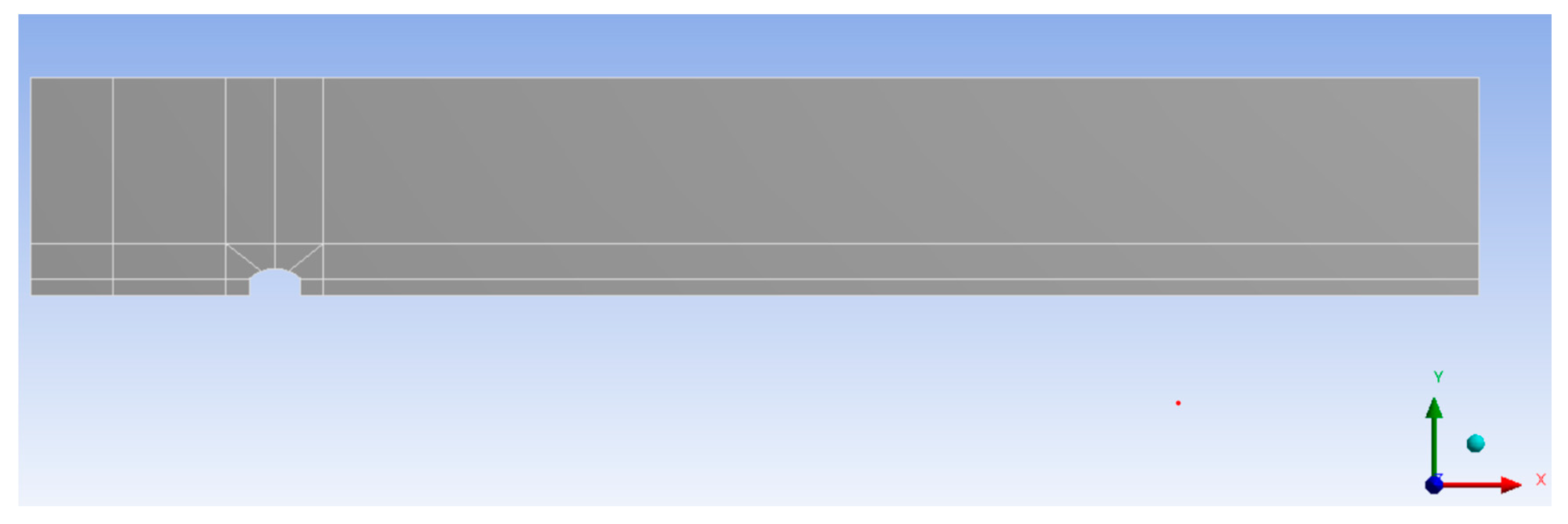


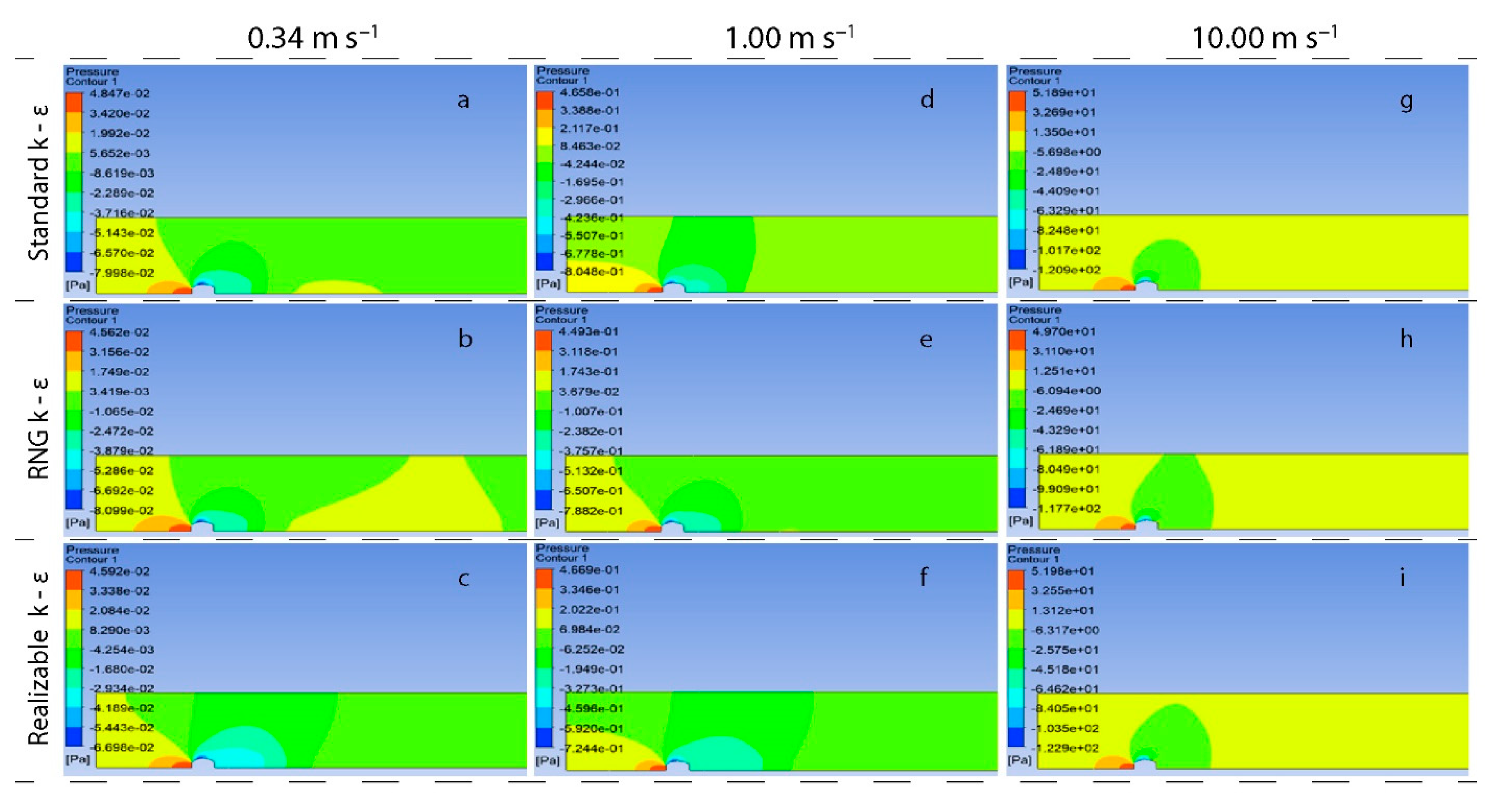

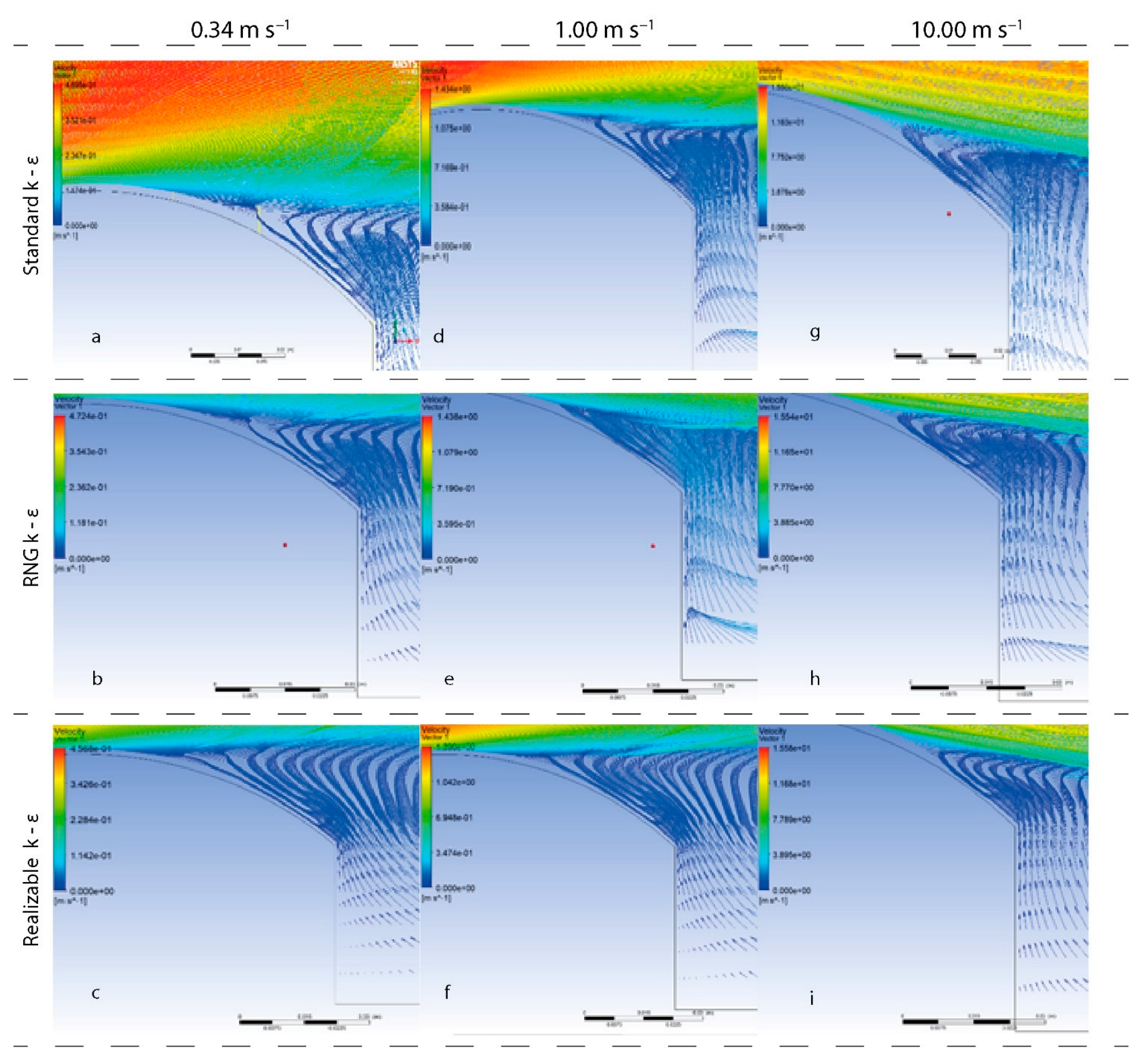
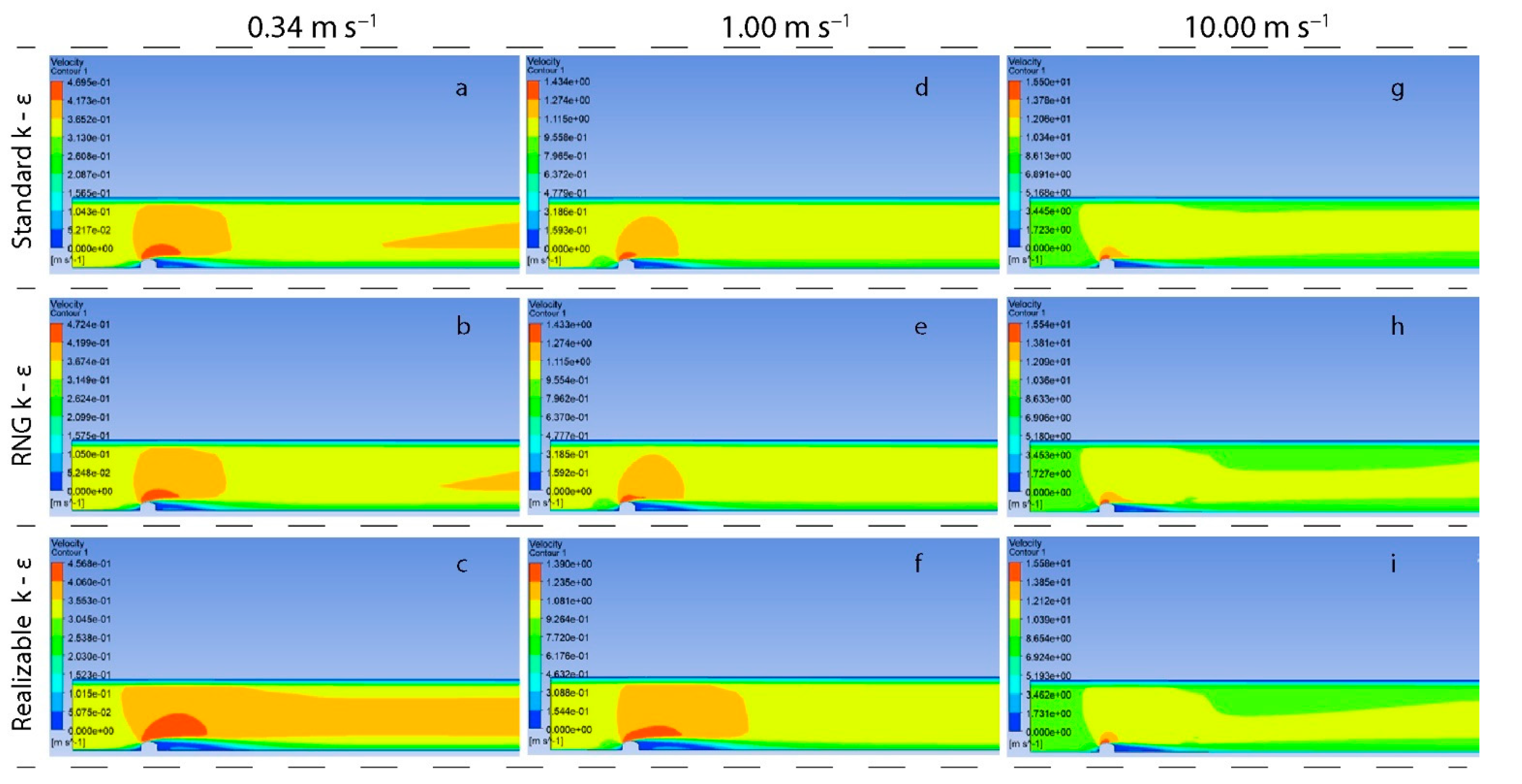


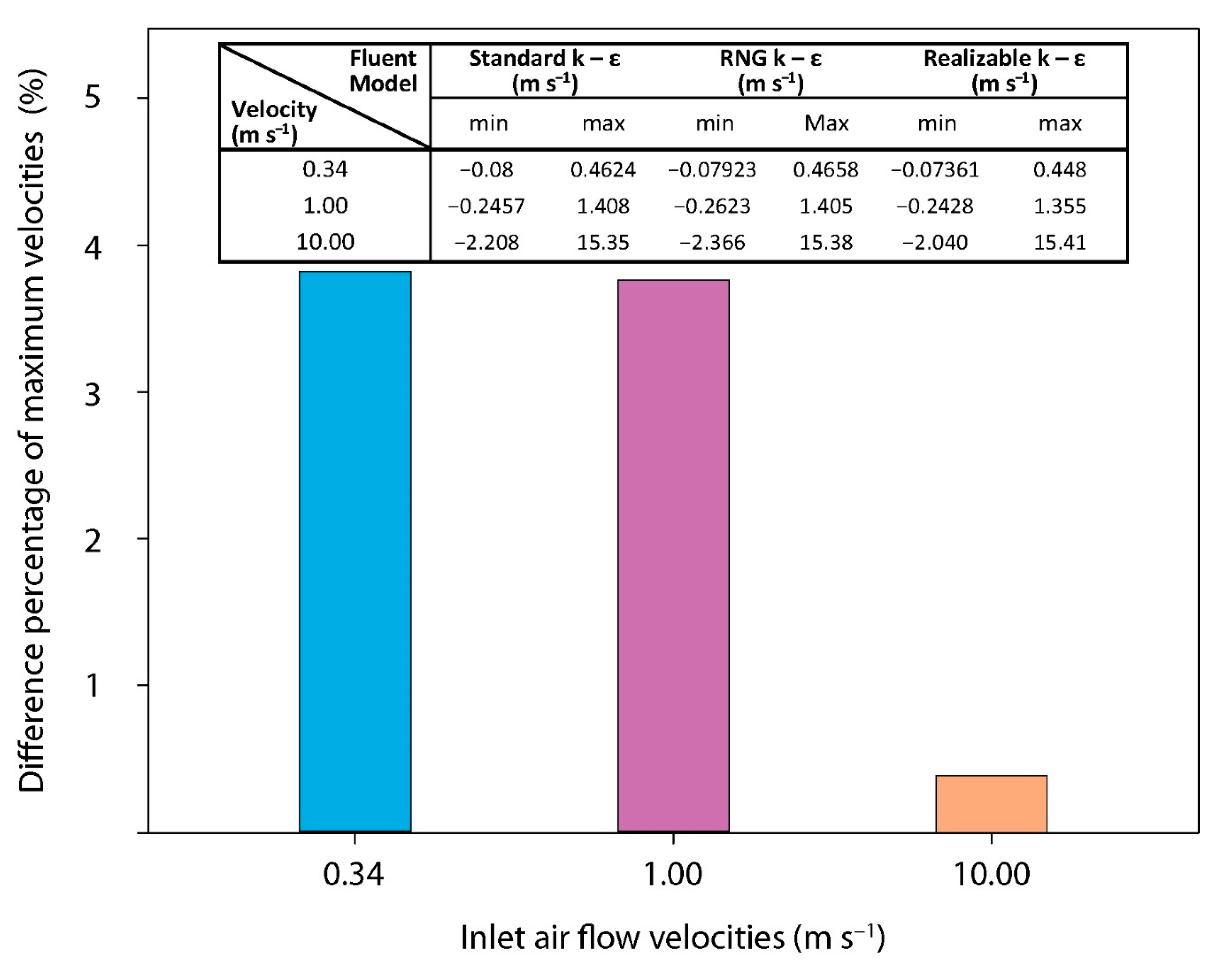



| Fluent Model | Re | Standard k–ε | RNG k–ε | Realizable k–ε | |
|---|---|---|---|---|---|
| Velocity (m s−1) | |||||
| 0.34 | 1364.33 | ✓ | ✓ | ✓ | |
| 1.00 | 4012.73 | ✓ | ✓ | ✓ | |
| 10.00 | 40127.38 | ✓ | ✓ | ✓ | |
Publisher’s Note: MDPI stays neutral with regard to jurisdictional claims in published maps and institutional affiliations. |
© 2022 by the authors. Licensee MDPI, Basel, Switzerland. This article is an open access article distributed under the terms and conditions of the Creative Commons Attribution (CC BY) license (https://creativecommons.org/licenses/by/4.0/).
Share and Cite
Partheniotis, G.; Kalamaras, S.D.; Martzopoulou, A.G.; Firfiris, V.K.; Fragos, V.P. Turbulence Models Studying the Airflow around a Greenhouse Based in a Wind Tunnel and Under Different Conditions. AgriEngineering 2022, 4, 216-230. https://doi.org/10.3390/agriengineering4010016
Partheniotis G, Kalamaras SD, Martzopoulou AG, Firfiris VK, Fragos VP. Turbulence Models Studying the Airflow around a Greenhouse Based in a Wind Tunnel and Under Different Conditions. AgriEngineering. 2022; 4(1):216-230. https://doi.org/10.3390/agriengineering4010016
Chicago/Turabian StylePartheniotis, Georgios, Sotirios D. Kalamaras, Anastasia G. Martzopoulou, Vasileios K. Firfiris, and Vassilios P. Fragos. 2022. "Turbulence Models Studying the Airflow around a Greenhouse Based in a Wind Tunnel and Under Different Conditions" AgriEngineering 4, no. 1: 216-230. https://doi.org/10.3390/agriengineering4010016






